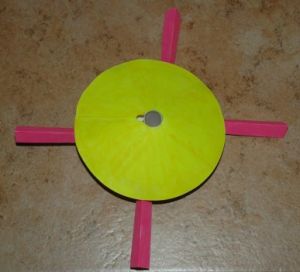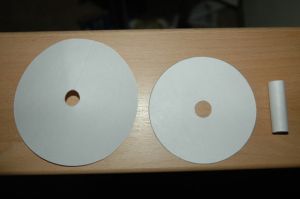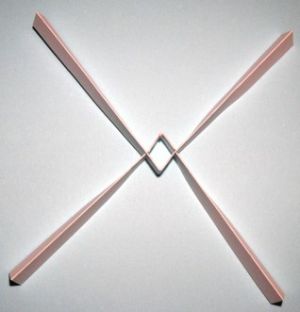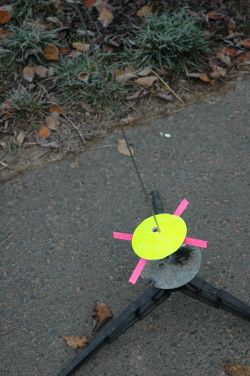Scratch U.F.P.O. (Unidentified Flying Paper Object) Original Design / Scratch Built
Scratch - U.F.P.O. (Unidentified Flying Paper Object) {Scratch}
Contributed by Joe Policy
| Manufacturer: | Scratch |

Brief:
My first paper rocket design--and it actually worked the first time!
Construction:
All that's needed is one 8 1/2" X 11" Sheet of 120# cardstock and
white glue.
I started by taking a CD-ROM and using it as a template for the upper portion of the saucer. I traced both the outside of the CD as well as the spindle hole in the center. After cutting out the both circles, I slit the circle from the edge to the center hole. I then made a cone by overlapping the cut edges by 1". I used a hole punch to make a small hole for the launch rod to pass through. I then cut out another circle that was 3.75" wide with a 14mm hole in the center. This part will attach under the cone to give it support. Another small hole was punched for the launch rod.
 Next was the motor
mount. I rolled it around a spent 13mm motor and applied glue to hold it
together. Once dry, I assembled the three pieces. I first glued the motor mount
so that it was centered over the hole in the upper cone, being careful to keep
it vertical. Once this assembly had dried, I put glue around the outer edge of
the lower support circle, placed it over the motor mount, and pressed it into
the place. You must be careful to line up the launch lug holes during assembly.
Next was the motor
mount. I rolled it around a spent 13mm motor and applied glue to hold it
together. Once dry, I assembled the three pieces. I first glued the motor mount
so that it was centered over the hole in the upper cone, being careful to keep
it vertical. Once this assembly had dried, I put glue around the outer edge of
the lower support circle, placed it over the motor mount, and pressed it into
the place. You must be careful to line up the launch lug holes during assembly.
While the main assembly was drying, I cut out the fins. To make the fins easier to fold in half, I lightly scored them lengthwise with my hobby knife. Once they were folded, I folded them in half lengthwise, making a V shape. I measured 1/2" from the crease and cut out notches half way through the fins. I notched the fins so that the crease would be facing upwards. When you place the fins on top of each other, they resemble an X. I put glue on the seams where the notches meet up.
 Once the fin
assembly had dried, I mounted them to the upper assembly. The square formed in
the middle of the fin assembly was a perfect fit over the motor mount. I added
more glue in and around the areas where the fins touched the upper assembly.
Once the fin
assembly had dried, I mounted them to the upper assembly. The square formed in
the middle of the fin assembly was a perfect fit over the motor mount. I added
more glue in and around the areas where the fins touched the upper assembly.
Finishing:
I used a yellow highlighter for the cone and a pink one for the fins. Not my
favorite color combination, but they were the only colors that I had.
Flight:
Launch day was definitely cold but fortunately, the winds were fairly light.
There was no prepping needed for this saucer. My first motor selection was an
A10-PT. My little saucer really took off fast, so I never was able to get a
picture--only smoke. Flight was a bit wobbly but it really got up there.
I figured that since this rocket was so light, I could use a much smaller motor and still get respectable altitude. Second flight was on 1/2A3-4T. Still fast off the pad, but it barely got any height. In fact, the rocket landed engine up while the tracking smoke was still burning. The pop from the ejection charge flipped the saucer back upright. Aside from residue from the ejection on the cone, there was no damage.
 Last flight was
back to the A10-PT and it was another great one. A gust of wind did take the
rocket downrange a bit, but with tumble recovery, you never had to walk far!
Last flight was
back to the A10-PT and it was another great one. A gust of wind did take the
rocket downrange a bit, but with tumble recovery, you never had to walk far!
Summary:
This is a very simple design that surprised me with its performance. And based
on the success of this design, I am now encouraged to see what else I can come
up with.
Sponsored Ads
 |
 |











